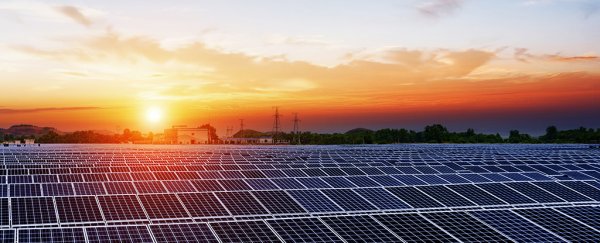We're seeing some fantastic strides forward in renewable energy, but the problem is there's a lot of non-renewable energy to phase out – and the latest calculations suggest we aren't replacing it anywhere near as fast as we need to be.
The research indicates we need a complete energy overhaul by 2050 to avoid catastrophic climate change, but at our current rate of progress it's not going to take another 30 years – it's going to take another 363 years.
By that time it's likely to be too little too late, as temperatures rise and ice melts. Those are the figures put forward by Ken Caldeira from the Carnegie Institution for Science in Washington DC, speaking to James Temple at MIT Technology Review.
Calderia and his colleagues published their first assessment in 2003, but in the 15 years since, we haven't been doing all that well. Rather than adding 1,100 megawatts of clean energy a day, we've managed an average of just 151 megawatts.
That's the equivalent of an extra 125,000 homes getting powered by renewable energy every single day. That's not terrible, but we need to be doing a lot more.
"It's a quantum leap from where we are today," Daniel Schrag, from Harvard University in Massachusetts, told MIT Technology Review.
The reasons for our sluggish reaction to the problem of climate change are many and varied. Replacing an entire planet's energy network is costly and time-consuming, not to mention politically and technically challenging.
Stopping energy production from fossil fuels tomorrow would be fantastic from an environmental standpoint – but it would also leave a lot of people out of work, send plenty of companies to bankruptcy, and leave many areas without power when the wind wasn't blowing or the Sun wasn't shining.
In other words, shifting to better energy solutions is complicated.
Part of the issue is that a lot of the effects of global warming will be delayed: by the time rising sea levels, uninhabitable regions, and mass migration are right in front of us, it'll be too late to make the necessary changes.
"Is it possible to accelerate by a factor of 20?" asks Schrag. "Yeah, but I don't think people understand what that is, in terms of steel and glass and cement."
On average, people are reluctant to pay more than $5 a month extra on their household bills, even if it would completely solve global warming, recent surveys show. When the same surveys were carried out 15 years ago, that figure was $10.
There is some hope: the progress we're making on electrifying heat production, which accounts for more than half of global energy production, should help us get at least a little closer to our targets, according to Caldeira.
Meanwhile, governments around the world are waking up to the seriousness of the problem. Regulations and taxes on fossil fuels and carbon dioxide production are likely to be the only way to drive the kind of investment in clean energy that's needed.
We're also learning more all the time about how the planet is changing and how human activity is shifting the balance of temperatures and climate. Even if our efforts have fallen short so far, giving up is not an option.
The opportunity to reach the necessary energy goals by 2050 may have passed, but any step in the right direction – whether sweeping government reform or something small we commit to individually – is going to help pull us away from the worst-case scenarios.
And that's the message from Harvard's Daniel Schrag too: the outlook may be bleak, but that's all the more reason to redouble our efforts, not an excuse to stop trying. "If you miss 2050, you still have 2060, 2070, and 2080," he says.
